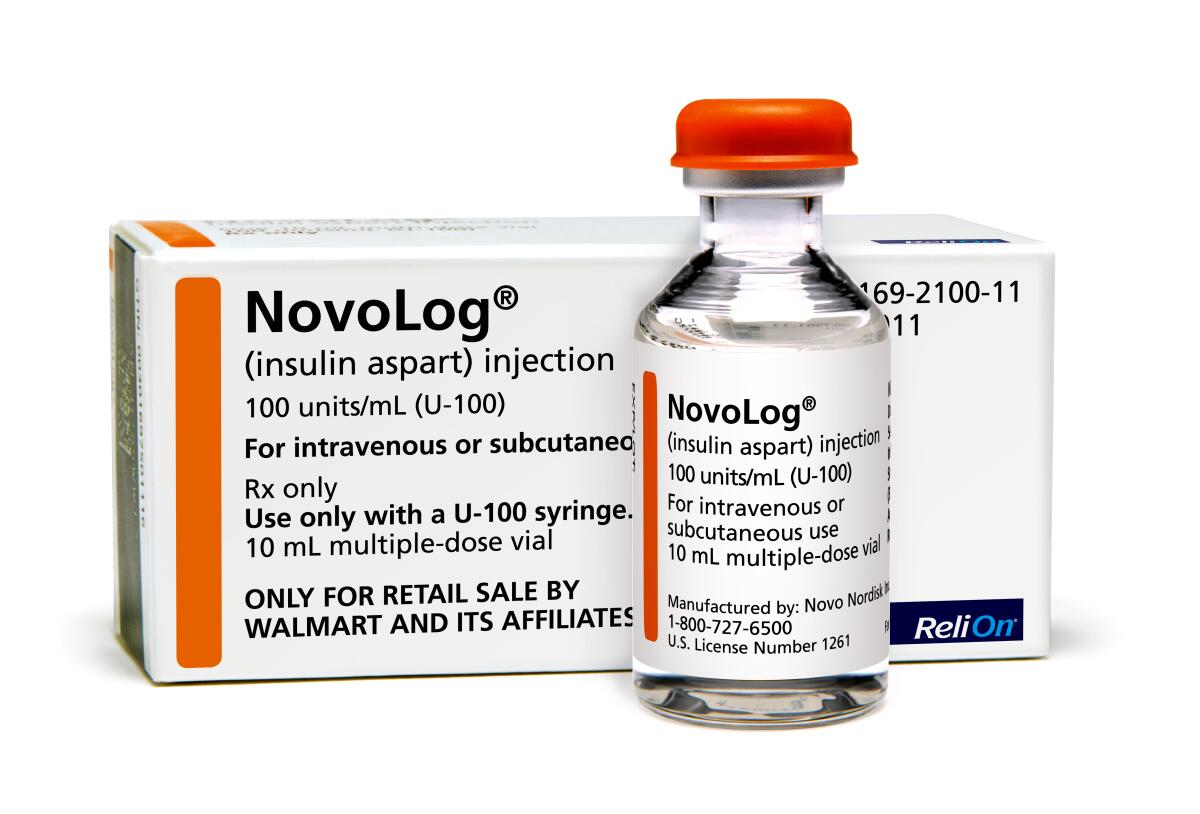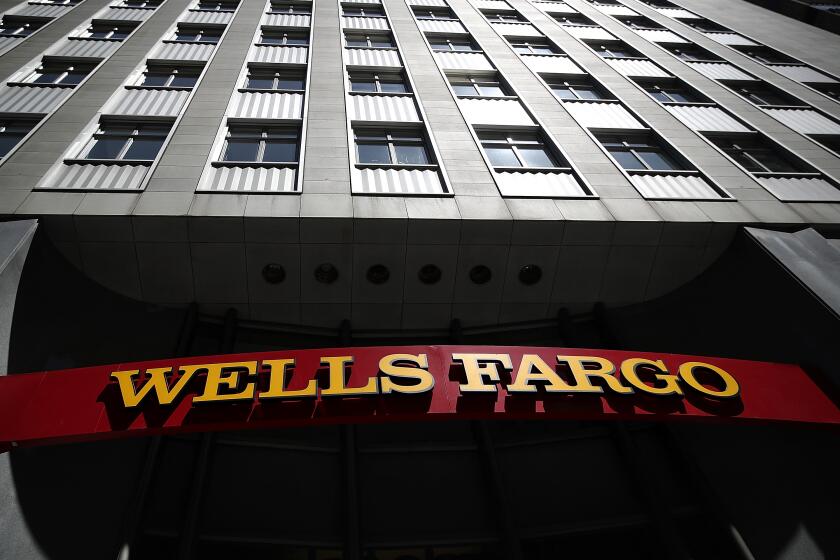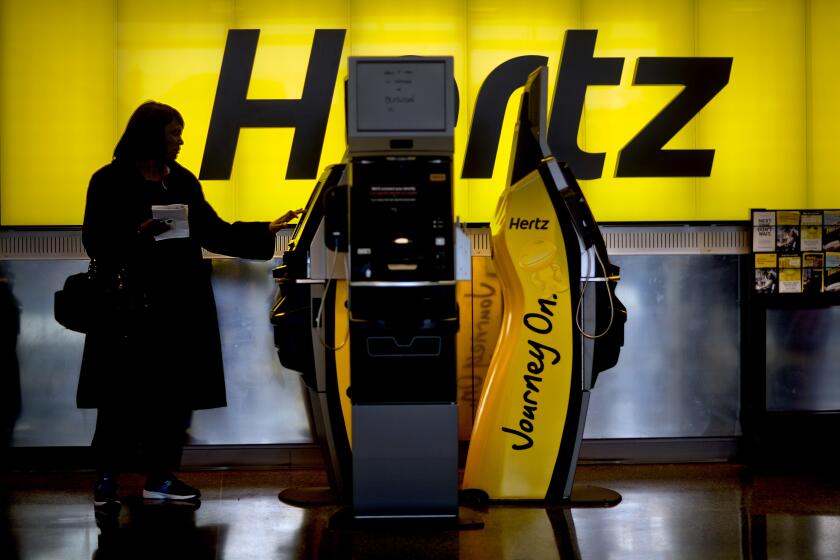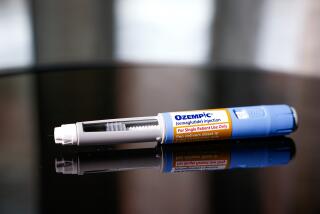Column: Soaring insulin prices reveal clout, and greed, of healthcare middlemen

- Share via
Politicians for years have been making a show of wringing their hands over sky-high prescription drug prices. And no drug has drawn more scrutiny, or calls for action, than insulin.
Insulin was discovered 100 years ago by a trio of Canadian scientists. They sold the patent to the University of Toronto for a mere $1.
The patent was made available royalty-free to drug companies to foster widespread use of the life-saving hormone.
Drug companies, in turn, did what they do best: They cashed in.
After decades of steady price hikes by manufacturers, a vial of insulin now costs about $300 — roughly 30,000% more than the original cost of the patent.
“Insulin has been the poster child for illogical drug pricing for some time,” said Geoffrey Joyce, director of health policy for USC’s Leonard D. Schaeffer Center for Health Policy & Economics.
And now comes new research showing that the three drug companies that dominate global insulin sales — Novo Nordisk, Eli Lilly and Sanofi — may not be entirely to blame for the soaring costs to people with diabetes (including myself).
Blame a profit-hungry horde of middlemen as well.
Wells Fargo had found a way to charge some of its customers $30 to transfer funds from one division of the bank to another when paying off a mortgage.
Researchers at USC found that drugmakers’ share of revenue from insulin sales has declined in recent years — and a greater share is being siphoned off by pharmacy benefit managers, drugstores, wholesalers and insurers.
In 2014, the researchers determined, 30% of insulin revenue went to middlemen. By 2018, those same middlemen were receiving 53% of insulin expenditures.
Is it any wonder American drug prices are the highest in the world? More than half the revenue from one of the most widely prescribed medicines is being gobbled up by layers of intermediaries standing between manufacturers and patients.
“The middlemen, and particularly pharmacy benefit managers, have been effective in negotiating lower prices from manufacturers,” said Karen Van Nuys, an assistant professor at the USC Sol Price School of Public Policy and one of the lead researchers of the study.
“What they haven’t been doing is sharing gains from those lower prices with patients,” she told me. “They’ve been keeping them.”
Pharmacy benefit managers, or PBMs, are companies that haggle with drugmakers on behalf of insurers and large employers. In theory, they play a vital role in preventing drug companies from charging whatever they please for prescription meds.
In reality, as the new data show, PBMs keep much of the savings for themselves rather than passing them along to patients.
But, again, they’re only one of multiple layers of middlemen cutting themselves in for a piece of the action.
“Everyone thinks drug manufacturers are the problem,” Van Nuys said. “In the case of insulin, it’s not just them — even though the middlemen are happy to have people think it’s the manufacturers.”
Making matters worse, she observed, the greater share of insulin revenue going to intermediaries places pressure on the drug’s manufacturers to keep raising prices so their own profits don’t suffer.
“It’s unconscionable,” Van Nuys said. “Market forces are working in favor of shareholders rather than patients.”
A UCLA-affiliated clinic charged more than $800 for a boot to treat a broken foot. The same exact boot can be found on Amazon for about $80.
Asked to comment on the USC study, which was published this month in JAMA Health Forum, Pharmaceutical Research and Manufacturers of America, the drug industry’s main lobbying group, was happy to point an accusing finger at pharmacy benefit managers.
“Pharmacy benefit managers play a powerful role in determining how much patients pay out of pocket for prescription medicines, yet these middlemen operate with very little transparency and accountability,” said Debra DeShong, a spokesperson for the organization.
“Every year they extract tens of billions of dollars in rebates from drugmakers, yet too often these savings are not shared with patients at the pharmacy,” she said, adding that “PBMs help perpetuate a broken system.”
Greg Lopes, a spokesperson for the Pharmaceutical Care Management Assn., representing PBMs, countered that high insulin prices are primarily the fault of “pricing strategies used by drug manufacturers to avoid competition.”
“PBMs have stepped up efforts to help patients living with diabetes by providing clinical support and education that result in better medication adherence and improve health outcomes,” he said.
Neither side deserves a get-out-of-jail-free card.
Drugmakers price branded prescription drugs at levels that far exceed their R&D and marketing costs — and they maintain high prices even after their costs have been recovered by years of economies of scale.
PBMs and other middlemen, meanwhile, add redundancies to the U.S. healthcare system that drive up overall costs. And all too often they place their own interests ahead of patients’.
According to the Mayo Clinic, insulin in the United States costs about 10 times what it costs in other developed countries.
Van Nuys said her team’s findings were possible because of state laws passed in recent years bringing greater transparency to insulin sales.
“Unfortunately, we lack similar data for other drugs,” she said. “It’s impossible to shine a light on the broader problem.”
That’s deliberate. Drugmakers, insurers and all those middlemen do all they can to keep secret how much money changes hands.
They say such data are “proprietary.” That’s just another way of saying they don’t want anyone spoiling their fun.
An L.A. man can prove he was on a plane awaiting takeoff when Hertz says he returned his rental car. Nevertheless, Hertz imposed a late fee.
The $1.75-trillion “Build Back Better” bill passed by the House this month would help remedy that. If signed into law, the bill would limit how much drugmakers could jack up some prices annually and set a limit on out-of-pocket spending for Medicare beneficiaries.
It also would cap patient copays for insulin at $35 for a 30-day supply, starting in 2023. But that’s only for people with private insurance or on Medicare. The millions of Americans who lack health insurance would still be on their own.
The bill also wouldn’t address insulin price increases. It’s just a limit on copays.
That means drugmakers would still keep trying to fleece insurers with ridiculous list prices, insurers in turn would keep raising people’s premiums, and the middlemen would keep serving themselves larger portions of the financial pie.
As usual, our politicians are reaching for Band-Aids when surgery is required. The $4-trillion U.S. healthcare system is a model of inefficiency and price gouging (as my recent column about a nearly 1,000% markup for medical equipment attests).
No one begrudges healthcare companies’ earning a fair profit.
What the insulin market shows, however, is that our current system is rigged, and has been for decades, and not in patients’ favor.
More to Read
Inside the business of entertainment
The Wide Shot brings you news, analysis and insights on everything from streaming wars to production — and what it all means for the future.
You may occasionally receive promotional content from the Los Angeles Times.














